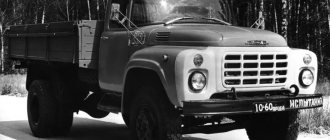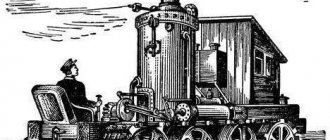GAZ-66 KUNG in the parking lot of army vehicles
The GAZ-66 all-wheel drive truck was produced by the Gorky Automobile Plant for 35 years. It owes such a long production period to its successful design features and technical characteristics, which make the car capable of moving off-road without any problems. At the same time, the GAZ-66 has retained sufficient efficiency as a universal vehicle that uses ordinary roads to transport various goods and people.
Since its creation, the machine has proven itself in the most difficult operating conditions, for which it deservedly bears the title “legendary”. In everyday life, the famous SUV received the name “Shishiga”, in which this word, meaning “swamp spirit”, was consonant with the model number, and without any negative context.
Modifications of GAZ-66
There are several modifications of the GAZ-66 truck.
- 01 - equipped with a tire pressure regulation system.
- 02 - equipped with a military winch and a tire pressure regulation system.
- 04 - there is electronic control with a screen.
- 15 - has all of the above and a military winch.
- 11 - considered the basic classic model.
- 40 - equipped with a turbo diesel engine.
- 31 — dump truck chassis installed.
- 41 - a naturally aspirated diesel engine is installed.
- 40 – turbo diesel GAZ-5441 installed.
- 92 - made specifically for the northern regions of the country.
- 96 - equipped with bus chassis.
The designers produced a car with increased stability and power.
All-terrain GAZ-66
To better distribute the load on the axles, the GAZ-66 cabin is located directly above the engine.
Main technical characteristics of the car
- Has a load capacity of up to 2000 kg;
- Can carry a maximum of 5900 kg;
- The model, together with the winch, has a length of 5.806 m, a width of 2.322 m, and a height of the car without loads of 2.520 m;
drawing of the GAZ 66 truck with dimensions - Cabin height – 2,490 m;
- Ground clearance is 31.5 cm;
- The front wheels create a track of 18 cm, and the rear wheels 17.5 cm. The car turns with a radius of 9.5 meters;
- The car overcomes a ford 800 cm deep;
- The new models have an 8-cylinder, liquid-cooled engine;
- The car has a working volume of 4254 cm3;
- The transfer case has a reduction gear and a switchable front axle;
- Operates with a power of 120 horsepower;
- The gearbox is manual, with 4 steps, synchronizers in 3rd and 4th gears;
- Two drive options - all-wheel drive and rear-wheel drive;
- Wheels are installed on special wheels with a split rim and rings on sides from 8 to 18. Tires – 12 – 18;
- The level of pressure in the wheels is from 0.5 to 3 kg per cm2;
- The maximum speed reaches 90 km/h;
- Fuel tank capacity 210 l;
- At a speed of 70 km/h, the car “eats” 18 liters of gasoline every 100 km;
- Drives on gasoline A-72, A-76, AI-80;
- The car's generator operates at a maximum current of 85 A;
- The battery capacity is 75;
- The cylinder blocks are cast from aluminum, equipped with liners, and covered with anti-corrosion cast iron on top;
- Pistons are tin-plated, made of aluminum;
- Develops maximum power of 115 horsepower at 3200-3400 rpm;
- Electrical equipment operates at 12 Volts;
- Ignition coil B114;
- 4-speed gearbox, manual with synchronization in 2nd and 4th gears;
- 2.8 kg per m2 – pressure indicator in the front and rear tires;
- The pressure can be reduced to 0.5 kg/cm2, but the vehicle speed should be no more than 20 km/h;
- The control mechanism is a worm with hydraulic booster and a gear ratio of 20.8.
Militarized three-axle trucks with a 6x4 wheel arrangement
Family "Ural-377" (1965-1983)
Single-sided 7.5-ton trucks Ural-377N
with an engine of 180 horsepower, a front axle from a MAZ-500 and wide-profile tires, they were modified national economic vehicles, which served in limited quantities in the Armed Forces of the USSR for transporting along rear lines of communication all kinds of cargo, ammunition and equipment for the construction of military pipelines.
Militarized road vehicle Ural-377N with a wooden body and wide-profile tires
Column of flatbed trucks Ural-377N for long-distance transportation of pipes of various diameters
377C truck tractors were produced in small batches
and
377SN
, working in conjunction with OdAZ-828 semi-trailers-vans with solid bodies (cabins). They housed equipment for radar, headquarters and air defense missile systems, control rooms and automated command posts at various levels of control.
Serial multi-purpose truck tractor Ural-377S (photo by the author)
Ural-377SN with OdAZ-828 semi-trailer of the Osnova command post
ZIL-133G (1975-1977)
In the mid-70s, the Moscow Automobile Plant for a short time produced the national economic eight-ton, 150-horsepower ZIL-133G1 truck with a balancer suspension of the rear gable wheels. It was planned to be used on public rear roads for the delivery of military cargo, repair equipment and elements of pontoon-bridge structures.
Truck ZIL-133G1 with a wooden cargo platform and folding sides. 1975 (photo by S. Andreev)
Engine Specifications
Engine capacity is 4250 cm3, runs on AI-76 and AI-80 gasoline. The car is designed even for severe operating conditions and develops power up to 120 horsepower at 3200 rpm.
This is what a GAZ-66 engine looks like.
Diesel is practically not installed on gas 66, mainly gasoline engines. The car can reach speeds of up to 90 km/h, but when the limiter is removed, the engine can be accelerated to 110-120 km/h, which reduces the service life and causes the mechanisms to wear out.
Purpose
When creating the model, the designers were guided by the desires of the military sphere. The vehicle was used in the army to transport airborne troops. There were also other areas of application:
- oil industry;
- gas industry;
- forestry;
- geology.
The equipment transported drilling tools, heavy equipment, and instruments. In modern conditions, the car is used for active recreation of tourists on the coast.
Gas 66
Gearbox Specifications
GAZ-66 was developed specifically for work in difficult terrain. The gearbox is mechanical, four-speed. The car successfully overcomes steep slopes. If driving on a road with good surface, the driver has the opportunity to disable the front axle to save fuel.
The car is equipped with 2 tanks of 105 liters each, which makes it possible to travel up to 800 km at a speed of 25 km/h. But when working in real conditions, the numbers come out differently.
GAZ-66 gearbox diagram
Tuning
Reliable and durable GAZ-66 cars, due to their mass production, are quite widespread and continue to be fully operational even two decades after the end of their mass production. This is largely due to the various tuning that most cars have undergone. It has become a popular practice to replace the engine with more powerful and economical diesel versions, which also requires changing the gearbox.
However, most often the owners of “Shishig” use external tuning: unusual color schemes for painting the car, treating the body with anti-corrosion materials, installing auxiliary lighting, installing arched tires to further increase cross-country ability. The body kit uses a “kanguryatnik”, and the KUNG version is complemented by a massive roof rack.
An example of a particularly impressive shishigi tuning
An equally important aspect of improving the former army all-terrain vehicle was tuning the interior: installing good sound insulation, replacing seats with more comfortable ones. The most popular solution for a KUNG van was its transformation into a comfortable “mobile home.” Most often, hunters and fishermen do this, not only equipping themselves with a place to spend the night, including multiple places, but also supplementing it with all sorts of amenities of modern civilization.
Short description
GAZ-66 is distinguished by a high level of power, reliability and wear resistance. Passes on any roads with heavy loads. The car is capable of transporting 2 tons of cargo off-road.
The differential locking of the front and rear axles is carried out automatically, large clearances and pressure regulation in the wheels create excellent cross-country ability (the wheel rims are designed according to a special design), and a special engine-driven device is installed to inflate the tires. The gas 66 engine is equipped with a pre-start heater.
In operating condition, a gas 66 brake system with separate hydraulics and a vacuum booster is used, and when parked, drum brakes with a transmission are used. The hydraulic booster is controlled using the steering wheel.
Power steering diagram
One of the technical features of the truck is the ideal balancing of the center of gravity, the vehicle is distinguished by its compactness, and the cabin is located above the engine itself, which allows the load to be evenly distributed between the front and rear axles, which is why the vehicle was used by airborne troops: during a parachute drop, the vehicle lands on all 4 wheels and does not fall over.
But in the 80s of the last century, the car was not used in Afghanistan because of m, which increased the danger during a mine explosion.
That is why the GAZ-66 was withdrawn from Afghanistan and decided to be mothballed at military bases. But the equipment had to stand in mothballed form for a long time, so the oil seals and tires, and the engines, deteriorated. In the 90s of the last century, the Ministry of Defense began selling previously mothballed equipment.
military model GAZ-66 with a kung.
The kung was especially popular - a car in which radio stations were located. In the 90s, the GAZ-66 began to be written off en masse, and then the GAZ 3308 with an extended chassis came to replace it.
Car body characteristics
The body length is 5.8 m, width – 2.3 m, height – 2.5 m, which makes the car one of the most compact dump trucks in the world; wheelbase – 3.3 meters.
Drawing of a GAZ-66 car
The track width of the front wheels is 18 cm, the rear wheels are 17.5 cm, this means that on a simple road the car does not go beyond the track. In the prepared state, the weight of the machine reaches 3640 kg, and together with the load it is equal to 5970 kg. The load is distributed as follows: more than 2.7 tons fall on the front axle, and 3 tons on the rear axle.
The car will be able to carry 2 tons even on difficult terrain without damage.
The cabin is located high, which improves visibility for such a hoodless dump truck. But, according to drivers, it is difficult to constantly work at such a height. The cabin is extremely small, so when driving over rough terrain there is a risk of injury from impacts on the interior of the cabin. Access to the engine compartment is difficult.
But the dump truck automatically wins due to its uniform weight distribution and its compact dimensions, as well as the wide functionality that the GAZ-66 Kung model has. The car can be equipped with various equipment, a military winch, and a welding machine.
Goals and objectives for application
The main customer of all-wheel drive vehicles in the Soviet Union was the defense department. Therefore, the performance characteristics (tactical and technical characteristics) of the GAZ-66 were initially determined by the requirements that the military set for the vehicle as the main army truck, intended not only for transporting military personnel (here special attention was paid to airborne units), but also for the purpose of maximum “motorization” of various radio engineering and support units, the number and role of which in the modern army has steadily increased.
This was reflected in a large number of specialized modifications of the GAZ-66 model for individual military transport tasks, among which the most common were:
- command and staff vehicle-all-terrain vehicle R-142;
- oil tanker MZ-66 (as well as other special refueling vehicles for aircraft);
- medical vehicle for transporting sick and wounded AS-66;
- mobile sanitary and medical station (“mobile dressing room”) AP-2;
- disinfection unit with shower DDA-2.
The BM-21V salvo rocket system was mounted on the GAZ-66 chassis in a slightly shortened version. In addition, the vehicle was used to transport towed artillery systems (guns and mortars), but as these weapons were improved, its weight increased, so that this scope of use for the GAZ-66 lasted a relatively short time.
Both in the military and in the general civilian sphere, modifications of the GZSA-731 are widely used. They were specialized cargo vans: “Bread”, “Medicines”, “Mail”.
In general, a car adapted for off-road driving in the USSR did not experience problems with demand in a variety of sectors of the country’s economy: in agriculture, construction, geodesy and geological exploration. A dump truck and a truck tractor created on the basis of the GAZ-66 have found application in hard-to-reach rural areas.
Controllability
The vehicle's high cross-country ability is ensured by self-locking differentials and a fairly large clearance of 31.5 centimeters, which allows it to overcome bodies of water that exceed the ground clearance in depth.
The car is equipped with a separating hydraulic brake system, which will not allow you to move with the coasting on. But the hydraulic power steering makes it easier to handle difficult turns.
One of the main features of the car: the ideal location of the center of gravity, so the load is simply not felt.











